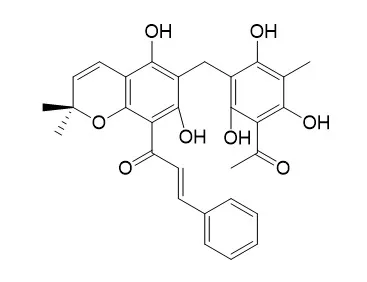| Kinase Assay: |
| Biochem Biophys Res Commun . 1994 Feb 28;199(1):93-98. | | Rottlerin, a novel protein kinase inhibitor[Pubmed: 8123051] | | Rottlerin, a compound from Mallotus philippinensis, is shown to inhibit protein kinases with some specificity for PKC. To some extent, the novel inhibitor is able to differentiate between PKC isoenzymes, with IC50 values for PKC delta of 3-6 microM, PKC alpha,beta,gamma of 30-42 microM and PKC epsilon,eta,zeta of 80-100 microM. Inhibition of PKC appears, at least in part, to be due to a competition between Rottlerin and ATP. Among the protein kinases tested, only CaM-kinase III is suppressed by Rottlerin as effectively as PKC delta. The chemical structure of Rottlerin might serve as a basis for the development of novel inhibitors with improved selectivity for a distinct PKC isoenzyme, such as PKC delta, or for CaM-kinase III. | | Antiviral Res . 2019 Aug;168:51-60. | | Kinase inhibitors tyrphostin 9 and rottlerin block early steps of rabies virus cycle[Pubmed: 31071352] | | Rabies virus (RABV) is a neurotropic virus that causes fatal encephalitis in humans and animals and still kills up to 59,000 people worldwide every year. To date, only preventive or post-exposure vaccination protects against the disease but therapeutics are missing. After screening a library of 80 kinases inhibitors, we identified two compounds as potent inhibitors of RABV infection: tyrphostin 9 and Rottlerin. Mechanism of action studies show that both inhibitors interfere with an early step of viral cycle and can prevent viral replication. In presence of tyrphostin 9, the viral entry through endocytosis is disturbed leading to improper delivery of viral particles in cytoplasm, whereas Rottlerin is inhibiting the transcription, most likely by decreasing intracellular ATP concentration, and therefore the replication of the viral genome. |
|
| Cell Research: |
| J Biol Chem . 2011 Aug 5;286(31):27363-27377. | | Protein kinase Ctheta is a specific target for inhibition of the HIV type 1 replication in CD4+ T lymphocytes[Pubmed: 21669868] | | Integration of HIV-1 genome in CD4(+) T cells produces latent reservoirs with long half-life that impedes the eradication of the infection. Control of viral replication is essential to reduce the size of latent reservoirs, mainly during primary infection when HIV-1 infects CD4(+) T cells massively. The addition of immunosuppressive agents to highly active antiretroviral therapy during primary infection would suppress HIV-1 replication by limiting T cell activation, but these agents show potential risk for causing lymphoproliferative disorders. Selective inhibition of PKC, crucial for T cell function, would limit T cell activation and HIV-1 replication without causing general immunosuppression due to PKC being mostly expressed in T cells. Accordingly, the effect of Rottlerin, a dose-dependent PKC inhibitor, on HIV-1 replication was analyzed in T cells. Rottlerin was able to reduce HIV-1 replication more than 20-fold in MT-2 (IC(50) = 5.2 μM) and Jurkat (IC(50) = 2.2 μM) cells and more than 4-fold in peripheral blood lymphocytes (IC(50) = 4.4 μM). Selective inhibition of PKC, but not PKCδ or -ζ, was observed at <6.0 μM, decreasing the phosphorylation at residue Thr(538) on the kinase catalytic domain activation loop and avoiding PKC translocation to the lipid rafts. Consequently, the main effector at the end of PKC pathway, NF-κB, was repressed. Rottlerin also caused a significant inhibition of HIV-1 integration. Recently, several specific PKC inhibitors have been designed for the treatment of autoimmune diseases. Using these inhibitors in combination with highly active antiretroviral therapy during primary infection could be helpful to avoid massive viral infection and replication from infected CD4(+) T cells, reducing the reservoir size at early stages of the infection. |
|
| Animal Research: |
| J Chromatogr Sep Tech . 2013 Jan 1;4(1):100062. | | Determination of Rottlerin, a Natural Protein Kinases C Inhibitor, in Pancreatic Cancer Cells and Mouse Xenografts by RP-HPLC Method[Pubmed: 24482742] | | Rottlerin is a natural polyphenolic ketone isolated from the pericarps of Mallotus phillippinensis. In previous studies we showed that parenteral administration of Rottlerin reduced tumor growth in murine xenograft models of pancreatic cancer. The aim of this study was to develop a simple and validated method for the quantitative determination of Rottlerin in plasma and tumor tissues of mice fed a Rottlerin diet. A xenograft model of pancreatic cancer was prepared by injection of 2×106 HPAF-II cells subcutaneously into nude mice. One week before tumor implantation, mice were randomly allocated to standard diet (AIN76A) and standard diet supplement with 0.012% Rottlerin (n=6 per group). Mice were sacrificed after 6 weeks on diets. Rottlerin was extracted from the plasma and tissues using protein precipitation-extraction and analyzed by reverse-phase HPLC-DAD method. The same HPLC method was also applied to determine Rottlerin levels in conditioned culture media and in cell lysates from HPAF-II cells exposed to 25 μM concentration of Rottlerin. A substantial amount of Rottlerin was detected in tumor (2.11 ± 0.25 nmol/g tissue) and plasma (2.88 ± 0.41 μM) in mice fed Rottlerin diet. In addition, significant levels of Rottlerin (57.4 ± 5.4 nmol/mg protein) were detected in cell lysates from Rottlerin-treated HPAF-II cells. These data indicate that Rottlerin is efficiently absorbed in cells and tissues both in vivo and in vitro and suggest a strong potential for Rottlerin as a preventive or adjuvant supplement for pancreatic cancer. |
|






 Cell. 2018 Jan 11;172(1-2):249-261.e12. doi: 10.1016/j.cell.2017.12.019.IF=36.216(2019)
Cell. 2018 Jan 11;172(1-2):249-261.e12. doi: 10.1016/j.cell.2017.12.019.IF=36.216(2019) Cell Metab. 2020 Mar 3;31(3):534-548.e5. doi: 10.1016/j.cmet.2020.01.002.IF=22.415(2019)
Cell Metab. 2020 Mar 3;31(3):534-548.e5. doi: 10.1016/j.cmet.2020.01.002.IF=22.415(2019) Mol Cell. 2017 Nov 16;68(4):673-685.e6. doi: 10.1016/j.molcel.2017.10.022.IF=14.548(2019)
Mol Cell. 2017 Nov 16;68(4):673-685.e6. doi: 10.1016/j.molcel.2017.10.022.IF=14.548(2019)